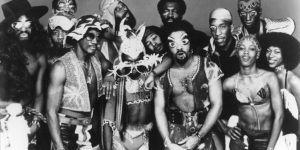CRAM SESSION: An intro to technical death metal gods Gorguts
by Jesse James Laderoute
March 29, 2016
Reexamine the Quebec metal legends' career before the release of their 'Pleaides’ Dust' EP.
Gorguts are a Canadian institution.
This may not be obvious to anyone whose boundaries of musical listening are drawn a bit more conservatively, but to fans of the more outre shades of extreme metal, they are universally respected and well loved, having established a reputation as one of the most technically impressive and uncompromising bands in a Quebec scene that has had more than its share (Voivod, Cryptopsy, Quo Vadis and Kataklysm, to name just a few whose influence stretches not just beyond the borders of Quebec but to the entire globe).
With the forthcoming release of Pleiades’ Dust, a new EP comprised of one 33-minute track that shifts moods and styles beyond what most bands accomplish in an entire career, there is no better time than now to reexamine the career of this godly band.
Considered Dead (1991)
Gorguts was formed in 1989 in the manufacturing town of Sherbrooke, Quebec by guitarist and vocalist Luc Lemay (as of this writing he is the only remaining original member), guitarist Sylvain Marcoux, bassist Éric Giguère and drummer Stéphane Provencher. The quartet quickly went to work establishing a reputation with their debut album, the inspiredly technical Considered Dead.
While slightly derivative of early Sepultura and groundbreaking tech death gods Death, the record does not suffer too much for it, and indeed holds up in a modern context where this musical language is now common. This means double bass riffing, chugging, an occasional blast and pained, guttural vocals.
If this seems like faint praise for a record that is in all respects an excellent debut, that said praise is relative only to what this band would eventually achieve later on. For posterity then, listen to the classic early death metal opening track, complete with a slightly dissonant but still pretty clean picked arpeggiated (fake?) acoustic intro.
The Erosion of Sanity (1993)
The follow-up to Considered Dead came two years later in the form of The Erosion of Sanity, and it is here where the characteristics that would come to define the best of Gorguts would begin to manifest.
The music was increasingly complex and more harmonically dissonant than before and Lemay’s vocal technique began to expand in its expressiveness, now encompassing a variety of pained shrieks and tortured yelps in addition to his usual guttural bark. In addition, Lemay’s early interest in classical forms begins to emerge in the piano intro and complex counterpoint of tracks like “Condemned to Obscurity.”
Roadrunner, the band’s label at the time, inexplicably dropped them after the record was released – a decision that they likely came to regret – and sidelined the band for five years. Still, The Erosion of Sanity is classic early tech death record on all accounts.
Obscura (1998)
There is almost no describing the effect that Obscura had on the metal community upon its release in 1998. Simply stated, it’s one of the greatest metal records ever made, equally groundbreaking, bizarre, complex and ambitious. To better understand what makes the music on this transgressive record such an impressive achievement, it’s necessary to dissect the constituent elements that make Obscura the greatest Gorguts record.
Using classical music as a point of reference for metal music is nothing new. It is often invoked as a means to describe particularly technically accomplished brands of metal because, like classical music, it is famously difficult to perform. Explaining this commonality can be an effective way to valourize or legitimize metal music to fans of music who can’t get past the naked aggression and noise common to the style.
However, rather than trading on the sort of neo-classical tradition found in the stylings of bands like Dimmu Borgir or Fleshgod Apocalpyse, where the goal seems to be a sort of outlandish Victorian theatre, this era of Gorguts in particular conjure the labyrinthine scaffolding typical of early 12 tone serialist composers Schoenberg, Berg, and Webern.
Of note is the fact that Obscura‘s “Earthly Love” is the one of the first tracks to feature a prominent use of strings, an increasing fascination for sole remaining member Lemay. As you can hear, the music on this album, even compared to earlier releases by Gorguts, is almost comically dissonant.
An important thing to consider while listening to music this maddeningly atonal is what it is about dissonant music that makes people uncomfortable. Bizarrely enough, this can, at least in part, be explained by going all the way back to the Inquisition – the Roman Catholic Church’s dogmatic quest to eradicate heretical (including Pagan) rituals and knowledge through sustained physical and epistemological violence. The church identified an harmonic interval used in Pagan music that they would refer to as “Diabolus in Musica”, which translates literally as “The devil in music”.
This harmonic interval is the suspended 4th chord, also referred to as the “tri-tone”, because it resides three whole tones from the root note of a given key and serves as the halfway point between a root and its octave. The tri-tone was historically thought by the Pagans to reveal truths about the golden ratio, an old world mathematical formula which they reasoned was capable of helping to explain certain parts of the geometry of nature. It has also been suggested that the interval was considered dangerous because it suggested freedom or, worse still, sex.
This, of course, was an affront to the Church, which was in the practice of discouraging understanding of the innerworkings of nature (and sex, for that matter). They began a dogmatic campaign to erase the suspended 4th from history by banning its use altogether under what became known as canon laws, justifying this action by claiming that the harmonic interval itself was evil.
Some historians suggest that the canon laws regarding standards of musical composition became the model by which other canon laws were written to stop the spread of all forms of heretical knowledge. While it remains unclear whether or not the use of violence was condoned to suppress this Pagan cultural object as it was in other parts of the Inquisition, it is clear is that the tri-tone was problematic for the Church in part because of its ties to Paganism. As a result its use was suppressed beginning by some accounts in the 13th century, though others suggest it could have begun as as early as the 9th.
The lasting effect of this is still felt in the sensibilities of music listeners today and indeed, music that doesn’t “resolve” itself melodically might sound displeasing to those whose sensibilities aren’t attuned to the joys of non-consonant music. A famous example of this effect can be found in the early part of the 20th century when “The Rite of Spring” by Igor Stravinsky created such a feeling of discomfort in its unsuspecting Paris audience upon its first performance in 1913 that it caused a riot when the emotional apex of the piece was reached. Clearly, these people were not quite ready to hear that shit.
Pieces of music such as this and earlier compositions by tri-tone popularizers Richard Wagner, who famously used the interval in his opera Tristan and Isolde, and Franz Liszt who employed its Satanic association to suggest Hell in his Dante Sonata helped lay the foundation for the deconstructionism of the traditional western system of musical composition by the 12 tone serialists (again: Schoenberg, Webern and Berg, among others) in the early part of the 20th century.
Still, outside of classical circles, the use of dissonance in western music was virtually non-existent until the tri-tone famously became the foundation of the opening riff for the song “Black Sabbath” by a new group called Black Sabbath on a record called Black Sabbath in 1970. Not only were Black Sabbath amongst the first bands to prominently use the tri-tone in the context of a rock band, (Hendrix did it too) but they made the connection between the tri-tone’s association with Satanism and the occult. This time audiences were more prepared. Here, metal’s obsession with using dissonance as a tool to titilate audiences began.
The scream is an effective tool for music making because it has a unique ability to effect the body both physically and emotionally. “He or she must really mean it”, you may have said at some point, while listening to a particularly pained, and by virtue of that, expressive vocal performance. It turns out that there’s something to this.
From an evolutionary standpoint, scientific consensus surmises that there are, in fact, a number of functions for screaming across the animal kingdom :
1. To intimidate or scare enemies who might otherwise cause you harm.
2. To signal pain as a way to attract the attention of someone who might be able to help you or to scare away predators.
3. To assert dominance by intimidating peers.
4. Out of shock or fright, again to signal danger to others, invite help and possibly frighten an attacker.
It turns out that people who claim that they can’t get into extreme metal because the singer sounds “scary” may have a point after all.
Indeed, it seems that the function of screaming in the context of metal may be to create abstract associations between the aggressive vocal performance and basic human emotions like fear, pain, and excitement. Upon being triggered, the centres of the brain responsible for these emotions respond to this stimulation by releasing a surge of dopamine – the neurotransmitter thought largely responsible for reward functions and pleasure – to the effected areas.
Horror films, incidentally a primary influence on countless metal bands, can be said to play on the confusing emotional relationship that results from portrayals of fear, pain and violence in much the same way that certain types of “scary” music does. They reward you.
But wait! There is much to adore in this record for fans of more modern deconstructionalists like Trout Mask Replica-era Captain Beefheart, free-jazzers, or the Providence, RI no wave revivalists.
As in the music of those touchtone genres, the rhythms on Obscura can seem to stop and start at random – though I assure you, it does not – and tempos shift and change as quickly as they began. This too, has an evolved psychological and physiological effect on the listener. Controlled experiments have demonstrated that shifting tempos and fast rhythms effect changes in the listener’s cardiovascular and respiratory systems as they work to mirror musical tempo and produce varying valences or affective responses. Simply put, a sudden blast of tempo shifts is confusing (and exciting) for your body.
This all amounts to a work that forces you to pay attention and be affected by it, and credit for this is surely due to the new band assembled by Lemay in the five-year break between The Erosion of Sanity and Obscura. This is not easy music to perform. An argument can be made that the instrumental interplay between drummer Patrick Robert, bassist Steve Cloutier, and the late guitarist Steeve Hurdle (who co-wrote much of the material), was unprecedented and remains, from a creative standpoint at least, unmatched.
If the goal of this music is to create feelings of unease, discomfort and excitement, then it can be said that this is ultimately achieved primarily through its use of these three things:
1) Extreme levels of dissonance, which as we’ve seen has been associated with taboo subjects like Satanism through institutional indoctrination.
2) Tortured screaming, which we subconsciously associate with danger, pain and violence and;
3) Frequent and complex shifts in rhythmic structure, which confuses our body’s natural tendency to align its processes with musical rhythm.
Obscura succeeds as art, not because it’s “fun” to listen to (it is for me) but because it conjures discomfort, fear, pain and confusion better than almost any other metal record, and it does so through its expertly measured manipulation of our shared psychology and physiology.
From Wisdom to Hate (2001)
It took another five years for Gorguts to deliver the follow-up with From Wisdom to Hate, an album somewhat less appreciated than it should be, due perhaps to its release after a record as game-changing as Obscura. In those five years, Steeve Hurdle left the band to pursue other interests (more on that later) and the differences are both obvious in some places and less so in others.
From Wisdom to Hate is much less immediately strange, that much is evident, but it also carves out the path of where Lemay’s interests would lie in the 12 years it would take to follow up this record (Hint: he wasn’t thinking about Gorguts). Check out the gothic Game of Thrones red wedding vibe on this intro to “The Quest for Equilibrium” before it evolves into the more “traditional” Gorguts scaffolding of tangled guitars, pained howling and bewildering blast beats.
Negativa – Negativa EP (2006)
In 2006 Lemay reteamed with Obscura co-author Steeve Hurdle, bassist Miguel Valade, and drummer Etienne Gallo to form Negativa and produced what can reasonably be termed a spiritual follow-up to that seminal record. That they only produced one 20-minute EP during their lifetime is a slight disappointment, but one that proves easier to digest while listening what they produced. There is enough music here for three records by almost any other band.
Lemay remained active in other ways during this sabbatical from Gorguts, though these activities did not always stay rooted in guitar based music. If you can manage to navigate the awful interface on Lemay’s MySpace page (!), I invite you to take a listen to a flute concerto he posted on the now antiquated website in around 2006 and perhaps it will be easier to understand the relationship between his compositional vision and that of the Stravinsky track posted above.
Colored Sands (2013)
Five years is a relatively long period to spend between albums, but compared to the length of time between From Wisdom to Hate in 2001 and Colored Sands in 2013 it seems almost completely reasonable for music of this level of complexity.
Sadly, part of the reason for the long absence must be attributed to the suicide of drummer Steve Macdonald in 2002 after the release of From Wisdom to Hate, which understandably led to an extended period of inactivity from the band. Lemay was not completely inactive during this time however, as his interest in alternate modes of composition here came to the fore.
By 2012 most fans of Gorguts were not holding out for a new record any time soon, if ever, but that which we didn’t know we deserved finally emerged in 2013 as Colored Sands, one of the best records in a dizzying strong catalogue. Prompted by his pal Hurdle from Negativa (and Obscura) to reform Gorguts when the improvisational element of Negativa wasn’t satisfying all of his creative urges, Lemay set about finding new players who could move the foundation of Gorguts towards a modern iteration.
Drummer John Longstreth, well known for his contributions to death tech wizards Origin was asked to join, as was Colin Marston of Krallice and Dysrhythmia and Kevin Hufnagel, also of Dysrhythmia. The classical training of the latter two allowed Lemay to work on even footing compositionally and the resultant attention to detail on Colored Sands is instantly noticeable.
This record, while not as staggeringly weird and consistently surprising as Obscura, stands as one of their best records because it both modernizes the Gorguts vision by adding elements of modern doom and post-rock but also because it is perhaps the most effectively moody sounding record in their catalogue. It is a record that contains both a string concerto and what may be the most brutal track in their entire discography in “Enemies of Compassion.”
Pleaides’ Dust (2016)
And here, 26 years after the release of their first demo, we find ourselves on the cusp of a new record by Gorguts. Conceived as a single track a la I by Meshuggah, Pleaides’ Dust, based on the clip of the shared six-minute preview of what is supposed to be a 33-minute piece of music, will expound on the more textural elements heard on Colored Sands and move the group into more patient and dynamic avant prog territory.
Drumming duties this time out fall on Patrice Hamelin, who replaces Longstreth and affirms once again that the only traditional thing about Gorguts is that their seeming inability to maintain a solid lineup since 1992 is one of the things that keeps them alive and vital well into their second decade, where a great many inferior bands are not. Long may they live.
Tags: Music, Featured, cram session, Gorguts





